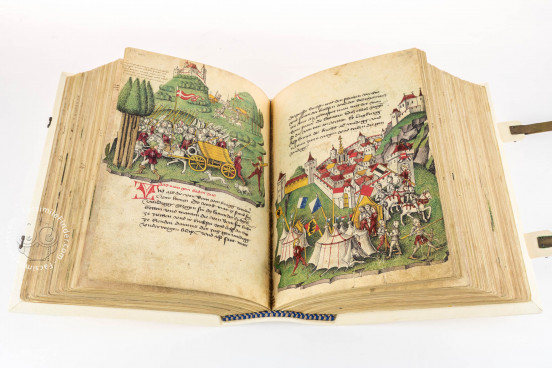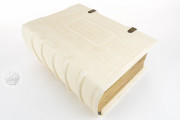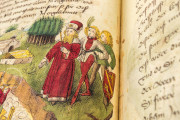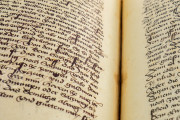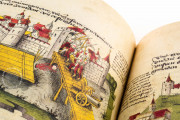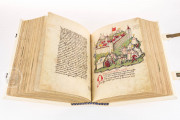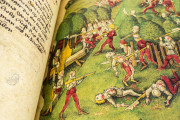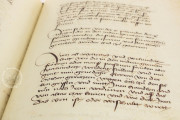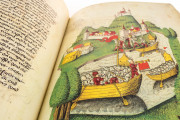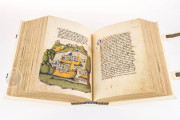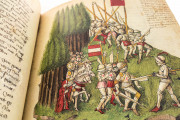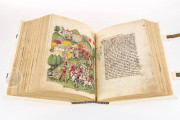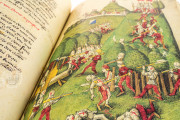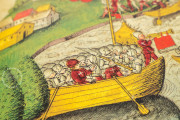The Bern Chronicle is the oldest surviving illustrated Swiss chronicle. The 230 unframed miniatures by Bendicht Tschachtlan, most executed on green backgrounds, clearly illustrate the text's narrative and provide a window into contemporary daily life and the city's history. Tschachtlan, a public servant in the municipal government of Bern, added to Konrad Justinger's earlier history of the city. The scribe, Heinrich Dittlinger, like Tschachtlan, was involved in the city's politics. They produced the manuscript in Bern around 1470.
In the illuminated chronicles of the fifteenth and sixteenth centuries, the Swiss Confederation created cultural documents of a very unique character. They all go back to a stunning work with an unbiased pictorial language of very special artistic charm. Tschachtlan's chronicle particularly fascinates because of its decoration, 230 mostly full-page coloured illustrations which, in line with the tradition of the Late Middle Ages, are characterised by a certain fresh light-heartedness. The pictures appear as relievo landscape sections and enchant the viewer by their vivid, expressive manner.
Tschachtlan: A Politician and Annalist Bendicht
Tschachtlan reputedly was a reliable, devoted statesman and administrator; an experienced and moderate person, he belonged to the well-situated, aspiring upper middle class. Out of his position close to the aristocracy, he always was mindful of his honor and reputation.
All in all, he worked for forty-five years in the public service. Tschachtlan was born around 1420. In 1448 he entered the Municipal Council of the City of Bern, in 1452 he married. As member of the Council in the years 1453 to 1493, he participated in important decisions regarding his city.
His activities included some of the most important public functions: finance and building, law, economy and control over ecclesiastical institutions. From the last quarter of the fifteenth century, Tschachtlan began to retire from certain official functions. The politician and annalist died late in 1493.
The Oldest Swiss Illuminated Chronicle
Tschachtlan's chronicle contributes some great innovations to the field of chronicles in general. First of all, it is the first illustrated chronicle as such; pictures were added to clearly illustrate the text.
Second, it contains the first comprehensive reproduction of the great annalists before Tschachtlan, in particular Konrad Justinger and Hans Fründ, in a single volume. And third, part of this chronicle served as a working base for Diebold Schilling's first work.
It is assumed that the young Schilling had an editorial function in Tschachtlan's chronicle. The text as such was written by Heinrich Dittlinger, another politician from Bern.
Both worked together to achieve this chronicle without public commission, on a purely private basis. In the epilogue they refer to themselves as the authors stating that the chronicle was completed in 1470.
The History of the Confederation from 1152 to 1470
Only a small part of the text is Tschachtlan's own work. The first part which deals with the time before 1431 is based on the Official Bern Chronicle by Konrad Justinger of the year 1431. In the second part, which recounts the old Zurich war, Tschachtlan refers to Hans Fründ's chronicle.
The rest goes back to the councellor himself. Tschachtlan considered it necessary to change any negative comments which former chroniclers had made on his home city of Bern. Bern and its history should appear in the best light.
However, as Bern was associated to the four founding cantons since 1323 and belonged to the Confederation of the eight cantons since 1353, Bern's history coincides with the history of the Swiss Confederation.
The Decoration
Tschachtlan's paintings reveal a stunning variety. His pictures are a real mine of information for any art historian eager to study weapons, clothing, uniforms, siege and battle techniques or even camp life of the time.
Tschachtlan's well-trained eye describes everyday life: trial scenes, life in the country, in the cities turmoil of war campaigns, siege and conquest.
Colorful events in the city and in the countryside, with special emphasis on the warlike conditions of the time, as well as the ways of great statesmen and the simple life of mercenaries, all is shown in this most interesting kaleidoscope of the chronicle. The work is a vivid testimony to Swiss history.
Binding description
Full-leather with embossing and clasps.
We have 1 facsimile edition of the manuscript "Bern Chronicle of Bendicht Tschachtlan": Tschachtlans Bilderchronik facsimile edition, published by Faksimile Verlag, 1986
Request Info / Price
